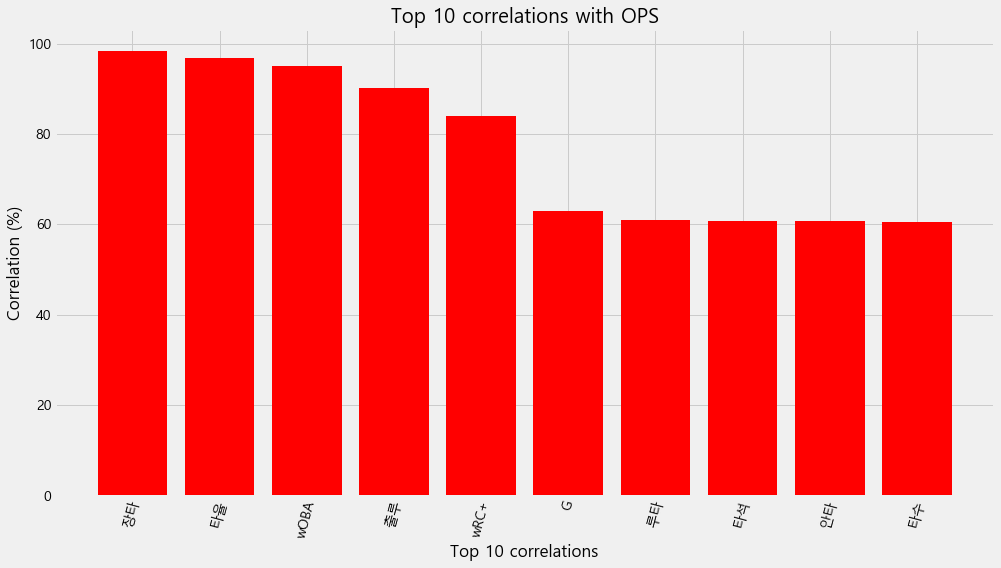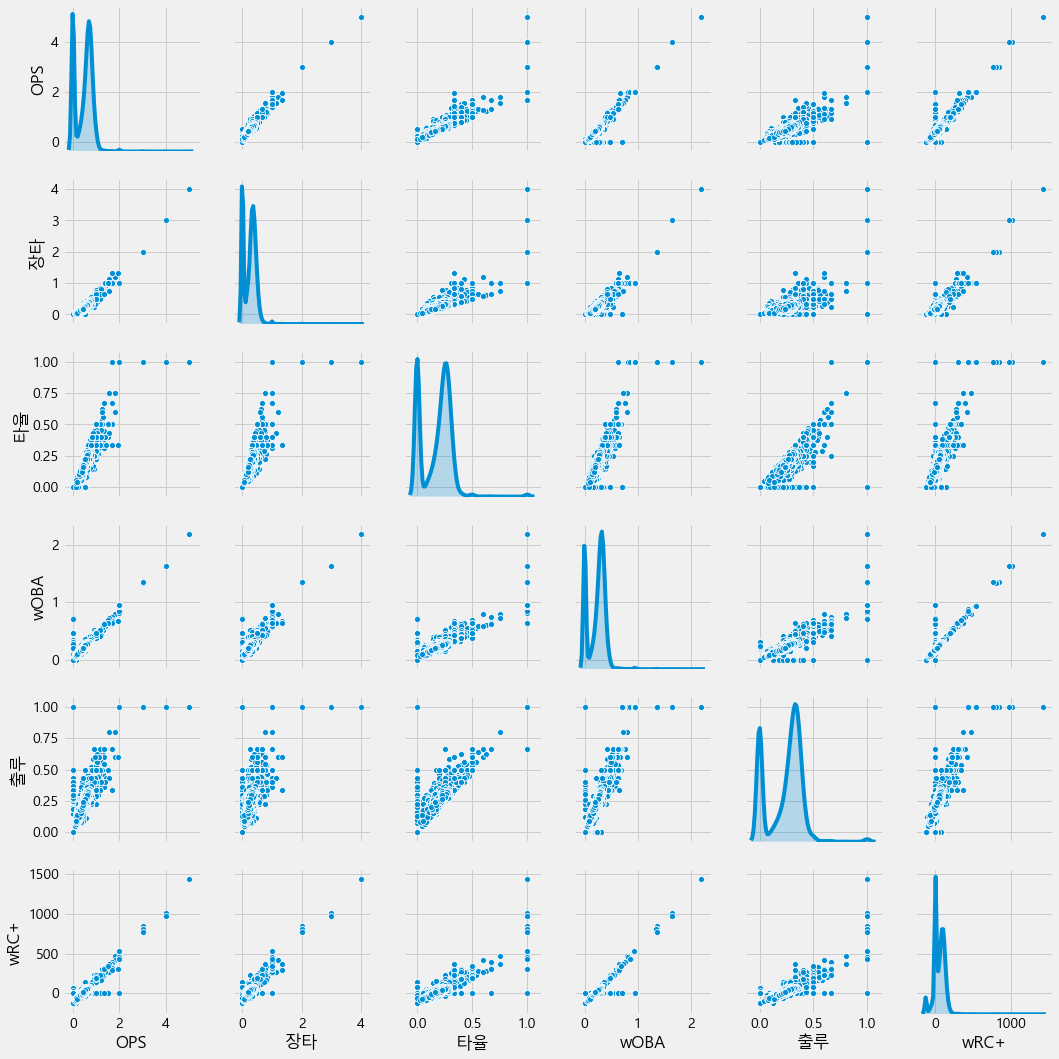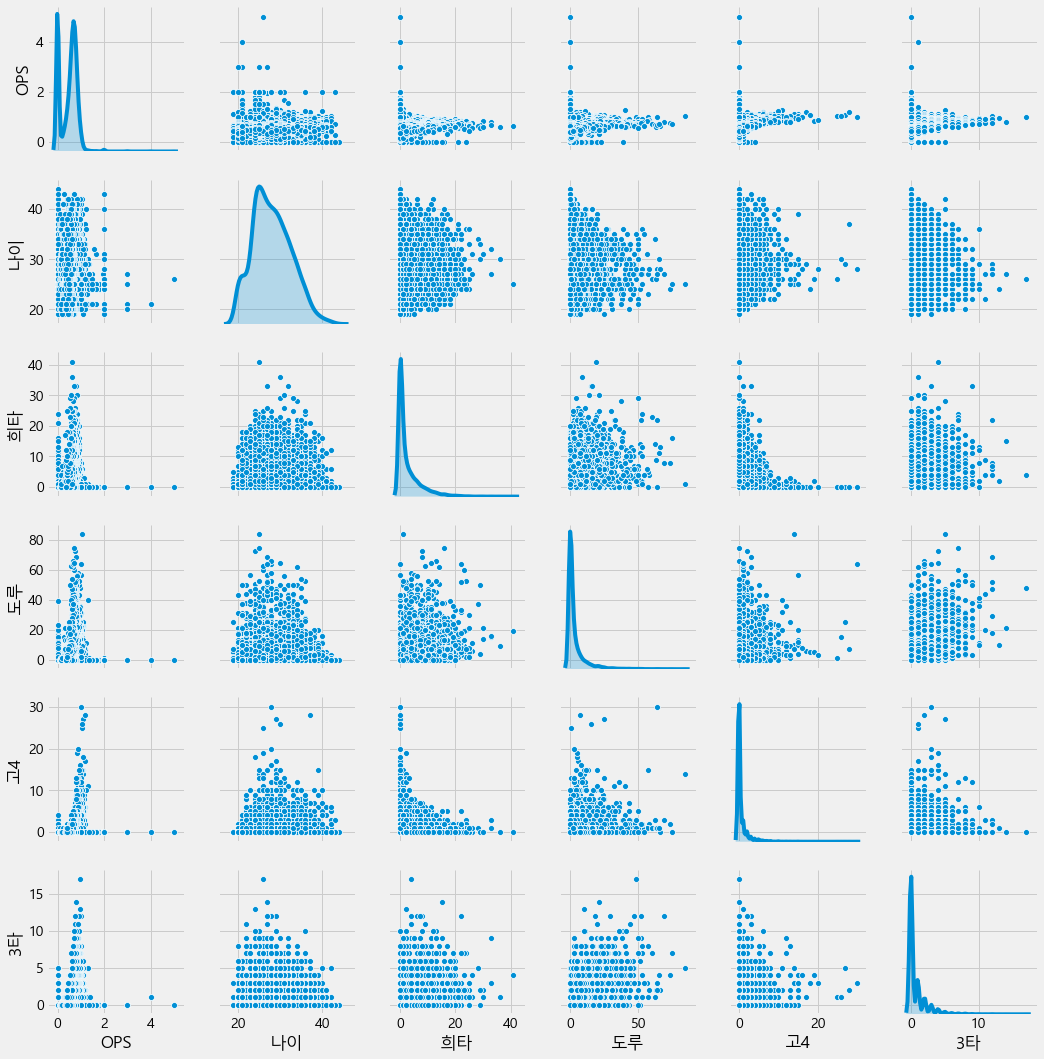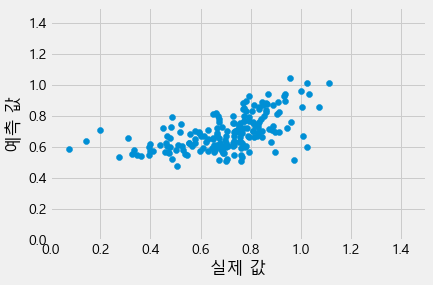- 대회설명: 2019년 이전의 KBO 타자 데이터를 활용하여 2019년 상반기 KBO 타자 OPS 예측
- 대회일자: 2019.02.08 ~ 2019.03.31
- 주관: Dacon
- 수상실적: 3위
2019년 KBO 타자 OPS 예측
1. Data Cleansing and Crawling
모듈
# matplotlib 한글 출력 가능하도록 만들기
from matplotlib import font_manager, rc
font_name = font_manager.FontProperties(fname="c:/Windows/Fonts/malgun.ttf").get_name()
rc('font', family=font_name)
# 데이터 크롤링 모듈
from selenium import webdriver
from bs4 import BeautifulSoup
import re
# 데이터 분석 모듈
import pandas as pd
import numpy as np
import matplotlib.pyplot as plt
import seaborn as sns
import time
from datetime import datetime
파일
submission = pd.read_csv("data/submission.csv")
reg = pd.read_csv("data/Regular_Season_Batter.csv")
STATIZ 크롤링
# 가상 웹드라이버 불러오기
# chromedriver.exe가 크롬 버젼에 맞게 설치 되어 있어야 함
driver = webdriver.Chrome('webdrivers/chromedriver.exe')
# 크롤링
for i in range(86):
# 1982년 부터 2018년 까지 statiz에 기록된 선수들 필터링 (총 8558명)
url = 'http://www.statiz.co.kr/stat.php?mid=stat&re=0&ys=1982&ye=2018&sn=100&pa={}'.format(i*100)
driver.get(url)
driver.implicitly_wait(5)
html = driver.find_element_by_xpath('//*[@id="mytable"]/tbody').get_attribute("innerHTML") #기록 table을 str형태로 저장
soup = BeautifulSoup(html, 'html.parser') #str 객체를 BeautifulSoup 객체로 변경
temp = [i.text.strip() for i in soup.findAll("tr")] #tr 태그에서, text만 저장하기
temp = pd.Series(temp) #list 객체에서 series 객체로 변경
#'순'이나 'W'로 시작하는 row 제거
# 즉, 선수별 기록만 남기고, index를 reset 해주기
temp = temp[~temp.str.match("[순W]")].reset_index(drop=True)
temp = temp.apply(lambda x: pd.Series(x.split(' '))) #띄어쓰기 기준으로 나눠서 dataframe으로 변경
#선수 팀 정보 이후 첫번째 기록과는 space 하나로 구분, 그 이후로는 space 두개로 구분이 되어 있음
#그래서 space 하나로 구분을 시키면, 빈 column들이 존재 하는데, 해당 column들 제거
temp = temp.replace('', np.nan).dropna(axis=1)
#WAR 정보가 들어간 column이 2개 있다. (index가 1인 column과, 제일 마지막 column)
#그 중에서 index가 1인 columm 제거
temp = temp.drop(1, axis=1)
#선수 이름 앞의 숫자 제거
temp[0] = temp[0].str.replace("^\d+", '')
# 선수들의 생일 정보가 담긴 tag들 가지고 오기
birth = [i.find("a") for i in soup.findAll('tr') if 'birth' in i.find('a').attrs['href']]
# tag내에서, 생일 날짜만 추출하기
p = re.compile("\d{4}\-\d{2}\-\d{2}")
birth = [p.findall(i.attrs['href'])[0] for i in birth]
# 생일 column 추가
temp['생일'] = birth
# page별 완성된 dataframe을 계속해서 result에 추가 시켜주기
if i == 0:
result = temp
else:
result = result.append(temp)
result = result.reset_index(drop=True)
print(i, "완료")
#column 명 정보 저장
columns = ['선수'] + [i.text for i in soup.findAll("tr")[0].findAll("th")][4:-3] + ['타율', '출루', '장타', 'OPS', 'wOBA', 'wRC+', 'WAR+', '생일']
#column 명 추가
result.columns = columns
#webdriver 종료
driver.close()
print("최종 완료")
0 완료
1 완료
2 완료
3 완료
4 완료
5 완료
6 완료
7 완료
8 완료
9 완료
10 완료
11 완료
12 완료
13 완료
14 완료
15 완료
16 완료
17 완료
18 완료
19 완료
20 완료
21 완료
22 완료
23 완료
24 완료
25 완료
26 완료
27 완료
28 완료
29 완료
30 완료
31 완료
32 완료
33 완료
34 완료
35 완료
36 완료
37 완료
38 완료
39 완료
40 완료
c:\users\user pc\appdata\local\programs\python\python37-32\lib\site-packages\pandas\core\frame.py:6211: FutureWarning: Sorting because non-concatenation axis is not aligned. A future version
of pandas will change to not sort by default.
To accept the future behavior, pass 'sort=False'.
To retain the current behavior and silence the warning, pass 'sort=True'.
sort=sort)
41 완료
42 완료
43 완료
44 완료
45 완료
46 완료
47 완료
48 완료
49 완료
50 완료
51 완료
52 완료
53 완료
54 완료
55 완료
56 완료
57 완료
58 완료
59 완료
60 완료
61 완료
62 완료
63 완료
64 완료
65 완료
66 완료
67 완료
68 완료
69 완료
70 완료
71 완료
72 완료
73 완료
74 완료
75 완료
76 완료
77 완료
78 완료
79 완료
80 완료
81 완료
82 완료
83 완료
84 완료
85 완료
최종 완료
result.shape
(8558, 28)
#결과값 저장해두기
result.to_csv("data/statiz_origin.csv")
데이터 전처리
선수정보
# 저장해둔 데이터 불러오기
# result = pd.read_csv("data/statiz_origin.csv", index_col=0)
# 이름 분리 해서, '이름' column 추가
result['이름'] = result['선수'].str.findall("^[ㄱ-힣]+").apply(lambda x: x[0])
# 기존 '선수' column 에 있던 이름 정보 제거
result['선수'] = result.apply(lambda x: x['선수'].replace(x['이름'], ''), axis=1)
# '시즌' column 생성
result['시즌'] = result['선수'].apply(lambda x: x[:2])
# 기존 '선수' column 에 있던 시즌 정보 제거
result['선수'] = result.apply(lambda x: x['선수'].replace(x['시즌'],''), axis=1)
# 년도를 4자리 숫자로 바꾸어주기 ex) 98 -> 1998, 15 -> 2015
result['시즌'] = result['시즌'].apply(lambda x: int("20"+ x) if int(x) < 30 else int("19"+x))
# 포지션
position = ['1B', '2B', '3B', 'SS', 'C', 'RF', 'LF', 'CF', 'DH']
# 포지션 여부 확인
result['포지션여부'] = result['선수'].apply(lambda x : (np.isin(x[-2:], position) or np.isin(x[-1:], position)))
# 포지션 분리
result['포지션'] = result['선수'].apply(lambda x: x[-2:] if x[-2:] in position else x[-1:])
#포지션이 기록 되어 있지 않으면, nan값 넣기
result.loc[result['포지션여부']==False, '포지션'] = np.nan
#statiz 사이트에, 2015시즌 조홍석 데이터에 생일이 기록 안되어 있음, 해당 시즌의 생일 추가
result.loc[(result.이름 =='조홍석'),'생일']
3475 1990-02-23
6466 0000-00-00
6855 1990-02-23
7874 1990-02-23
Name: 생일, dtype: object
result.loc[(result.이름 =='조홍석')&(result.시즌 ==2015),'생일'] = '1990-02-23'
result[(result.이름 =='조홍석')&(result.시즌 ==2015)].생일
6466 1990-02-23
Name: 생일, dtype: object
# 팀 & 나이 column 생성
result['팀'] = result.apply(lambda x: x['선수'].replace(x['포지션'],'') if type(x['포지션'])==str else x['선수'], axis=1)
result['나이'] = result.apply(lambda x: x['시즌'] - int(x['생일'][:4]) + 1, axis=1)
# 선수별 고유 아이디 부여
info = result[['이름', '생일']].apply(lambda x: tuple(x), axis=1)
player_id = {}
for i,j in enumerate(info.unique()):
player_id[j] = i
result['ID'] = result.apply(lambda x: player_id[tuple([x['이름'], x['생일']])], axis=1)
# submission에는 있지만, statiz에는 없는 이름 확인
# 선수가 이름을 개명하여 submission과 statiz에 다르게 기록됨
# statiz가 홈페이지를 업데이트를 할 때마다, 그리고 선수들이 개명을 할 때마다 다른 값이 나오므로,
# 해당 코드를 돌릴 때마다 이름이 다르게 나올 수 있음
# 윤여운 -> 윤수강 (submission : 윤수강 / statiz : 윤여운)
# 이유찬 -> 이병휘 (submission : 이병휘 / statiz : 이유찬)
submission[~np.isin(submission['batter_name'], result['이름'])]
| batter_id | batter_name | batter_ops | |
|---|---|---|---|
| 129 | 195 | 윤수강 | 0 |
| 138 | 208 | 이병휘 | 0 |
# 이름 변경
result['이름'] = result['이름'].replace("윤여운", "윤수강").replace('이유찬', '이병휘')
# numeric data로 변환
float_columns = result.iloc[:,1:27].columns
result[float_columns] = result[float_columns].astype(float).fillna(0)
# 필요한 features 선택
cols = ['ID', '이름', '생일', '팀', '시즌', '포지션', '나이'] + list(float_columns)
result = result[cols]
2. Visualization
print("<전체 column 타입확인>\n\n",result.dtypes.value_counts())
print()
print("<object type columns>\n\n",result.columns[result.dtypes=='object'])
<전체 column 타입확인>
float64 26
object 4
int64 3
dtype: int64
<object type columns>
Index(['이름', '생일', '팀', '포지션'], dtype='object')
# Find correlations with the target and sort
correlations = result.corr()['OPS'].sort_values()
# Display correlations
print('Most Positive Correlations:\n', correlations.tail(11))
print('\nMost Negative Correlations:\n', correlations.head(10))
Most Positive Correlations:
타수 0.605591
안타 0.607215
타석 0.607968
루타 0.609306
G 0.629138
wRC+ 0.840125
출루 0.901480
wOBA 0.951055
타율 0.967631
장타 0.982626
OPS 1.000000
Name: OPS, dtype: float64
Most Negative Correlations:
ID -0.584864
시즌 -0.090651
나이 0.172608
희타 0.283392
도루 0.318953
고4 0.343591
3타 0.353408
도실 0.380572
사구 0.452578
희비 0.466994
Name: OPS, dtype: float64
OPS와 높은 상관관계
- 장타, 타율, wOBA, 출루, wRC+, G,루타, 타석,안타
OPS와 낮은 상관관계
- 나이, 희타, 도루, 고4, 3타, 도실, 사구, 희비
plt.style.use('fivethirtyeight')
plt.figure(figsize=(15,8))
plt.bar(correlations.tail(11)[:-1].index.astype(str)[::-1], 100*correlations.tail(11)[:-1][::-1],color='r')
# Plot labeling
plt.xticks(rotation=75) ; plt.xlabel('Top 10 correlations'); plt.ylabel('Correlation (%)');
plt.title('Top 10 correlations with OPS')
Text(0.5, 1.0, 'Top 10 correlations with OPS')

plt.figure(figsize=(15,8))
plt.bar(correlations.head(10)[2:].index.astype(str), 100*correlations.head(10)[2:])
# Plot labeling
plt.xticks(rotation=75) ; plt.xlabel('Low 8 correlations'); plt.ylabel('Correlation (%)')
plt.title('Low 8 correlations with OPS')
Text(0.5, 1.0, 'Low 8 correlations with OPS')

#Top 5. High correlation with 'OPS' Pair Plot
print("Top 5. High correlation with 'OPS' Pair Plot")
high_corr = result.loc[:,list(correlations.tail(6)[::-1].index)]
sns.pairplot(high_corr,diag_kind='kde')
plt.show()
Top 5. High correlation with 'OPS' Pair Plot

- OPS와 선형성을 보이는 변수들이 있음
# Top5. Low correlation with 'OPS' Pair Plot
print("Top5. Low correlation with 'OPS' Pair Plot")
low_corr = result.loc[:,['OPS']+list(correlations.head(7)[2:].index)]
sns.pairplot(low_corr,diag_kind='kde')
plt.show()
Top5. Low correlation with 'OPS' Pair Plot

- OPS의 분포는 좁은 것에 비해서 상관성이 낮은 변수들은 분포가 넓음 (OPS 예측에 큰 도움이 안됨)
# dtype이 object인 것과 OPS 추출
result_obj=result.loc[:,list(result.columns[result.dtypes=='object'])+['OPS']]
# 포지션별 OPS violinplot 그려보기
plt.figure(figsize=(15,8))
sns.violinplot(x='포지션',y='OPS',data=result_obj)
plt.title("포지션별 OPS violinplot")
c:\users\user pc\appdata\local\programs\python\python37-32\lib\site-packages\scipy\stats\stats.py:1713: FutureWarning: Using a non-tuple sequence for multidimensional indexing is deprecated; use `arr[tuple(seq)]` instead of `arr[seq]`. In the future this will be interpreted as an array index, `arr[np.array(seq)]`, which will result either in an error or a different result.
return np.add.reduce(sorted[indexer] * weights, axis=axis) / sumval
Text(0.5, 1.0, '포지션별 OPS violinplot')

- violinplot: Box plot(분위수 확인)과 KDE plot(데이터의 분포 확인)을 동시에 할 수 있다
- C (포수) 포지션의 경우 다른 포지션에 비해서 outlier가 매우 큰 선수가 있는 것으로 보인다.
3. Feature Engineering
# 1루타 feature 생성
result['1타'] = result['안타'] - result['2타'] - result['3타'] - result['홈런']
# 사용 features 명시
infos = ['ID','이름','생일','팀','시즌','포지션','나이']
stats = ['G','타수','득점','안타','1타','2타','3타','홈런','루타','타점','도루','도실','볼넷','사구','고4','삼진'\
,'병살','희타','희비','타율','출루','장타','OPS','wOBA','wRC+','WAR+']
# 해당 시즌 이전까지의 누적 기록
def get_cumulative(player_id, season, stat=stats ,df=result):
try:
result_cum = df[(df['ID']==player_id) & (df['시즌'] < season)][stat]
result_cum = result_cum.mean()
except:
result_cum = [np.nan for i in stat]
result_cum = pd.Series(result_cum)
return result_cum
# 모든 stats에 대한 누적 stat
stats_cum = [i + '_누적' for i in stats]
# 누적 stat 데이터프레임에 반영
result[stats_cum] = result.apply(lambda x: get_cumulative(x['ID'], x['시즌']), axis=1)
# lag stat (직전 몇년의 기록)
def get_lag(player_id, season, lag, stat=stats, df=result):
try:
result_lag = df[(df['ID']==player_id)&(df['시즌'] == season-lag)][stat].values[0]
result_lag = pd.Series(result_lag)
except:
result_lag = [np.nan for i in stat]
result_lag = pd.Series(result_lag)
return result_lag
# 직전 1,2,3년의 기록
stats_lag1 = [i + '_LAG1' for i in stats]
stats_lag2 = [i + '_LAG2' for i in stats]
stats_lag3 = [i + '_LAG3' for i in stats]
# lag1
result[stats_lag1] = result.apply(lambda x: get_lag(x['ID'],x['시즌'], lag=1), axis=1)
# lag2
result[stats_lag2] = result.apply(lambda x: get_lag(x['ID'],x['시즌'], lag=2), axis=1)
# lag3
result[stats_lag3] = result.apply(lambda x: get_lag(x['ID'],x['시즌'], lag=3), axis=1)
# 내년 기록 (OPS, 장타, 출루)
# 데이터 프레임의 정답 셋 만들기 위함
def get_next_year(player_id, season, stat=['장타','출루','OPS'],df=result):
try:
result = df[(df['ID']==player_id)&(df['시즌']==season+1)][stat].values[0]
result = pd.Series(result)
except:
result = [np.nan for i in stat]
result = pd.Series(result)
return result
# 장타, 출루, OPS의 내년 기록
stats_next = [i + '_NEXT' for i in ['장타', '출루', 'OPS']]
result[stats_next] = result.apply(lambda x: get_next_year(x['ID'], x['시즌']), axis=1)
# 변환 데이터 저장
# result.to_csv("data/statiz_v2.csv")
4. Model Building
모델링
# 출력 할 때 마다, 기존 출력물들은 제거해주는 모듈
from IPython.display import clear_output
# 모델 모듈
from xgboost import XGBRegressor, plot_importance
from lightgbm import LGBMRegressor
from sklearn.ensemble import RandomForestRegressor
from sklearn.svm import SVR
from sklearn.linear_model import Ridge, Lasso, LinearRegression, ElasticNet
from sklearn.neighbors import KNeighborsRegressor
from sklearn.metrics import mean_squared_error, r2_score
from sklearn.preprocessing import StandardScaler, MinMaxScaler
df = result.fillna(-1) # nan값 -1로 impute
df = df[df['OPS_NEXT'] > 0] # 다음 해의 OPS가 존재하는 값들만 추출 (다음 해 OPS 가 없다면, predict 값과 target값을 비교 할 수 없기 때문)
df = pd.concat([df, pd.get_dummies(df['포지션'], drop_first=True)], axis=1) # 포지션 dummy variable로 변환
학습
# 사용 features 명시
infos = ['ID','이름','생일','팀','시즌','포지션','나이']
stats = ['G','타수','득점','안타','1타','2타','3타','홈런','루타','타점','도루','도실','볼넷','사구','고4','삼진'\
,'병살','희타','희비','타율','출루','장타','OPS']
# 누적 및 lag stat features 이름
stats_cum = [i + '_누적' for i in stats]
stats_lag1 = [i + '_LAG1' for i in stats]
stats_lag2 = [i + '_LAG2' for i in stats]
stats_lag3 = [i + '_LAG3' for i in stats]
# X features와 y feature 정리
stats_position = ['2B', '3B', 'C', 'CF', 'DH', 'LF', 'RF', 'SS']
X_cols = stats + stats_cum + stats_lag1 + stats_lag2 + stats_position + ['나이']
y_cols = ['OPS_NEXT']
# 학습시킬 모델
model_dict = {'xgb':XGBRegressor(n_estimators=110, learning_rate=0.05 ,max_depth=3, min_samples_split=400, random_state=23),
'lgbm':LGBMRegressor(),
'rf':RandomForestRegressor(),
'svr':SVR(),
'knn':KNeighborsRegressor(),
'reg':LinearRegression(),
'ridge':Ridge(),
'lasso':Lasso()}
# 2009 ~ 2016년 기간의 데이터로 검증
# 예를들어 2010년은 2009년까지의 데이터로, 2011년은 2010년까지의 데이터로 검증
# 에러가 가장 낮은 두 모델, xgboost와 ridge 중 ridge 선택
# ridge가 xgboost에 비해 과적합이 적고 일반화가 더 잘 이뤄졌을 것이라는 판단
test_error = []
r2 = []
for year in range(2010, 2018):
train = df[df['시즌'] < year-1].reset_index(drop=True)
test = df[df['시즌'] == year-1].reset_index(drop=True)
X_train = train[X_cols]
y_train = train[y_cols]
X_test = test[X_cols]
y_test = test[y_cols]
model = model_dict['ridge'] #모델명 바꾸어 가면서 실험 가능
weight = train['타수']
model.fit(X_train, y_train, sample_weight=weight)
y_predict = model.predict(X_test)
test_error.append(mean_squared_error(y_test, y_predict, sample_weight=X_test['타수']) ** 0.5)
r2.append(r2_score(y_test, y_predict))
clear_output(wait=True)
print(year, ": 완료")
print("test error : ", np.mean(test_error))
print("test std : ", np.std(test_error))
print("r2 : ", np.mean(r2))
print("완료")
2017 : 완료
test error : 0.12297661095675332
test std : 0.017695723649870054
r2 : 0.1972005395338279
완료
# 연도별 테스트 에러
test_error
[0.11965635488780504,
0.10017133715584686,
0.1113487547340026,
0.11995787803170647,
0.1585607101594155,
0.12152418699996415,
0.14271784504461912,
0.10987582064066678]
# 예측값과 실제값의 시각화
plt.scatter(y_test, y_predict)
plt.xlabel("실제 값")
plt.ylabel("예측 값")
plt.xlim(0,1.5)
plt.ylim(0,1.5)
(0, 1.5)

제출
predict = result[result['시즌']==2018] # 2018년도 데이터 프레임
predict = pd.concat([predict, pd.get_dummies(predict['포지션'], drop_first=True)], axis=1) # 포지션 dummy variable로 변환
# Dacon regular season과 submission 병합
# 추후 statiz data와 병합할 때 기준이 되는 생일 데이터를 얻기 위함
reg_sub = pd.merge(submission, reg[reg['year']==2018], on='batter_id', how='left', suffixes=['','_reg'])
# regular season dataframe의 생일 데이터를 statiz와 일치시킴
reg_sub['year_born'] = reg_sub['year_born'].apply(lambda x: datetime.strptime(x, "%Y년 %m월 %d일").date())
reg_sub['year_born'] = reg_sub['year_born'].astype(str)
# 필요한 feature만 남김
reg_sub = reg_sub[['batter_name', 'year_born', 'batter_id']]
# 이름과 생일을 기준으로 dacon data와 statiz data 병합
total = pd.merge(reg_sub, predict, how='left', left_on=['batter_name', 'year_born'], right_on=['이름', '생일'])
X = total[X_cols] # 사용 feature
X = X.fillna(-1) # NA값 -1로 impute
# 예측
total['y_hat'] = model.predict(X)
# 타자별 예측값 feature에 저장
submission['batter_ops'] = submission['batter_id'].apply(lambda x: total[total['batter_id']==x]['y_hat'].values[0])
# 제출 파일 생성
submission.to_csv("data/tnt_submission.csv", index=False, encoding='utf-8')
# 제출 결과 확인
sub = pd.read_csv('data/tnt_submission.csv')
sub
| batter_id | batter_name | batter_ops | |
|---|---|---|---|
| 0 | 1 | 강경학 | 0.658489 |
| 1 | 2 | 강구성 | 0.546550 |
| 2 | 3 | 강민국 | 0.592865 |
| 3 | 4 | 강민호 | 0.852663 |
| 4 | 5 | 강백호 | 0.894065 |
| 5 | 8 | 강상원 | 0.596299 |
| 6 | 9 | 강승호 | 0.600272 |
| 7 | 11 | 강진성 | 0.595175 |
| 8 | 12 | 강한울 | 0.601566 |
| 9 | 16 | 고명성 | 0.588540 |
| 10 | 18 | 고종욱 | 0.752714 |
| 11 | 19 | 구자욱 | 0.881511 |
| 12 | 20 | 국해성 | 0.640459 |
| 13 | 22 | 권정웅 | 0.606158 |
| 14 | 23 | 권희동 | 0.758239 |
| 15 | 24 | 김강민 | 0.738815 |
| 16 | 28 | 김규민 | 0.681435 |
| 17 | 101 | 문선재 | 0.596781 |
| 18 | 30 | 김동엽 | 0.815607 |
| 19 | 33 | 김동한 | 0.603093 |
| 20 | 35 | 김문호 | 0.708531 |
| 21 | 36 | 김민성 | 0.766009 |
| 22 | 37 | 김민수 | 0.532364 |
| 23 | 38 | 김민식 | 0.643187 |
| 24 | 335 | 홍성갑 | 0.544609 |
| 25 | 39 | 김민하 | 0.671040 |
| 26 | 40 | 김사훈 | 0.531915 |
| 27 | 41 | 김상수 | 0.719601 |
| 28 | 43 | 김선빈 | 0.796683 |
| 29 | 44 | 김성욱 | 0.702760 |
| ... | ... | ... | ... |
| 190 | 294 | 지석훈 | 0.558775 |
| 191 | 295 | 지성준 | 0.659402 |
| 192 | 300 | 채은성 | 0.917660 |
| 193 | 301 | 채태인 | 0.764336 |
| 194 | 307 | 최승준 | 0.706538 |
| 195 | 308 | 최영진 | 0.690007 |
| 196 | 309 | 최원제 | 0.678761 |
| 197 | 310 | 최원준 | 0.713414 |
| 198 | 311 | 최윤석 | 0.553565 |
| 199 | 312 | 최재훈 | 0.647541 |
| 200 | 313 | 최정 | 0.944987 |
| 201 | 314 | 최정민 | 0.657098 |
| 202 | 315 | 최주환 | 0.876702 |
| 203 | 316 | 최준석 | 0.670725 |
| 204 | 317 | 최진행 | 0.737720 |
| 205 | 318 | 최항 | 0.714403 |
| 206 | 319 | 최형우 | 0.993787 |
| 207 | 324 | 하주석 | 0.746670 |
| 208 | 325 | 하준호 | 0.663997 |
| 209 | 326 | 한동민 | 0.938371 |
| 210 | 327 | 한동희 | 0.678485 |
| 211 | 329 | 한승택 | 0.641606 |
| 212 | 331 | 허경민 | 0.826822 |
| 213 | 332 | 허도환 | 0.641374 |
| 214 | 334 | 호잉 | 0.890421 |
| 215 | 337 | 홍재호 | 0.593042 |
| 216 | 338 | 홍창기 | 0.643868 |
| 217 | 341 | 황윤호 | 0.565175 |
| 218 | 342 | 황재균 | 0.887563 |
| 219 | 344 | 황진수 | 0.625428 |
220 rows × 3 columns
